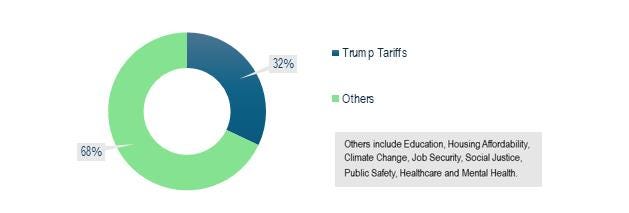The kick-off of the 2025 Canadian federal election campaign has set the stage for one of the most unpredictable and high-stakes political battles in the country’s modern history. And the world is watching. Just weeks ago, the Liberal Party of Canada, appeared to be in the final days of an almost 10-year run in government, trailing the Conservative Party by a daunting margin. However, Prime Minister Justin Trudeau’s resignation on January 6 and Mark Carney’s ascension to leadership of the Party have reshaped the political landscape. What was unimaginable two months ago is real: the Liberals are leading in voter intentions and are in a strong position to win.
Why Canada turned on a dime
First, Trudeau fatigue was the Conservatives’ strongest asset. Polling over the past several years showed a steady decline in his personal approval ratings, with many Canadians seeking change. By default, Pierre Poilievre’s Conservatives became the primary vehicle for that change. However, with Trudeau stepping aside and a new leader in place, that advantage has weakened. It’s worth asking whether Pierre Poilievre’s fervour was all about Trudeau fatigue or was there something else?
Second, the wildcard no one saw coming (or maybe some did): Donald Trump. His re-election campaign in the U.S. has turned from spectacle to existential threat for Canada. Trump’s aggressive rhetoric—including threats of an "economic war" against Canada, comments about making Canada the 51st U.S. state, and executive orders imposing tariffs on Canadian exports—has fueled concerns about economic instability. In fact, leading economists have already warned that these measures could push Canada into recession.
With the country staring down one of the most serious economic threats in its modern history—and its closest ally suddenly becoming its biggest economic adversary—this election is no longer just about picking a prime minister anymore—it’s about choosing Canada’s champion in an increasingly hostile global arena.
By now, Canadians are familiar with the two seismic shifts that have upended the election dynamics: the change in Liberal leadership from Trudeau to Carney, and the instability from President Donald Trump bringing Canadians together. Digging deeper into the sentiment of the Canadian electorate uncovers how these shifts are being approached by voters.
The Ballot Box Question: Who Can Stand Up to Trump?
Early in any election cycle, political analysts and strategists try to define the key "ballot box question"—the issue most likely to decide the outcome. In 2025, that question is clear: Which leader is best equipped to defend Canada against Donald Trump?
At Tactix, we deploy AI-based DeepLearning tools that provide real-time insights into voter sentiment, analyzing online conversations and public discourses. Our latest research reveals two important trends:
Canadians see this election as an economic referendum. Of all the issues that might confront Canadians, the imminent threat of Trump’s tariffs and the economic repercussions dominates public concern. Nearly one-third of the national discourse reflects frustrations and uncertainty over this issue (see Figure 1). This marks a significant shift from October when housing affordability was the foremost concern, with one in four discussions highlighting it as the most pressing issue. Yes, housing affordability remains a steady issue and cannot be dismissed in the current political landscape; however, the looming economic uncertainty resulting from Trump’s tariffs has surged to dominate the national conversation. The dramatic spikes in the engagement trend—one in late January and another in late February—suggests heightened public anxiety over tariffs (see Figure 2).
Figure 1: Issues of Concern to Canadians Between November 2024 and March 2025
(Tactix subscribed research tools analyzed over 1M online conversations of Canadians)
Figure 2: Tariffs vs. Housing Affordability: A Monthly Comparative Trend
(Tactix subscribed research tools analyzed over 1.2M online conversations of Canadians)
Beneath the surface, voters are worried about the viability of the country, with pressure coming from Canada-U.S. trade relations, the economy, the cost-of-living and potential job losses. In our observation of online conversations, 93% of Canadians are worried about the country’s viability when placed under the pressure that tariffs will bring. Canadians are discussing how these issues will impact their jobs, the cost of living, and their long-term economic security. Expect political parties to tailor their messaging accordingly over the remainder of the campaign.
Lessons from 1992: It’s Still the Economy, Stupid
During the 1992 U.S. presidential election, political strategist James Carville coined the now-famous phrase: “It’s the economy, stupid.” His message to Bill Clinton’s campaign staff was simple—focus on the economy, because that’s what voters care about most and might win us the election. In the context of the tariff war and how it has been framed by Donald Trump, it starts with the economy but doesn’t stop there. Canadians have realized there is a significant nation-building effort ahead of them, and an economy that is more independent of the U.S. and more resilient is a key part of that effort.
In Canada, the Conservatives initially sought to position this election as a referendum on change versus continuity. But with Trump’s return to power and the growing threat to Canada’s economic stability, the real issue has shifted. This election will be won by the leader who can convince voters they are best positioned to stand up to the U.S. president, defend Canada’s economic interests, and safeguard Canadian independence.
While much remains uncertain in this campaign, one thing is clear: the road to victory once again runs through the economy.





